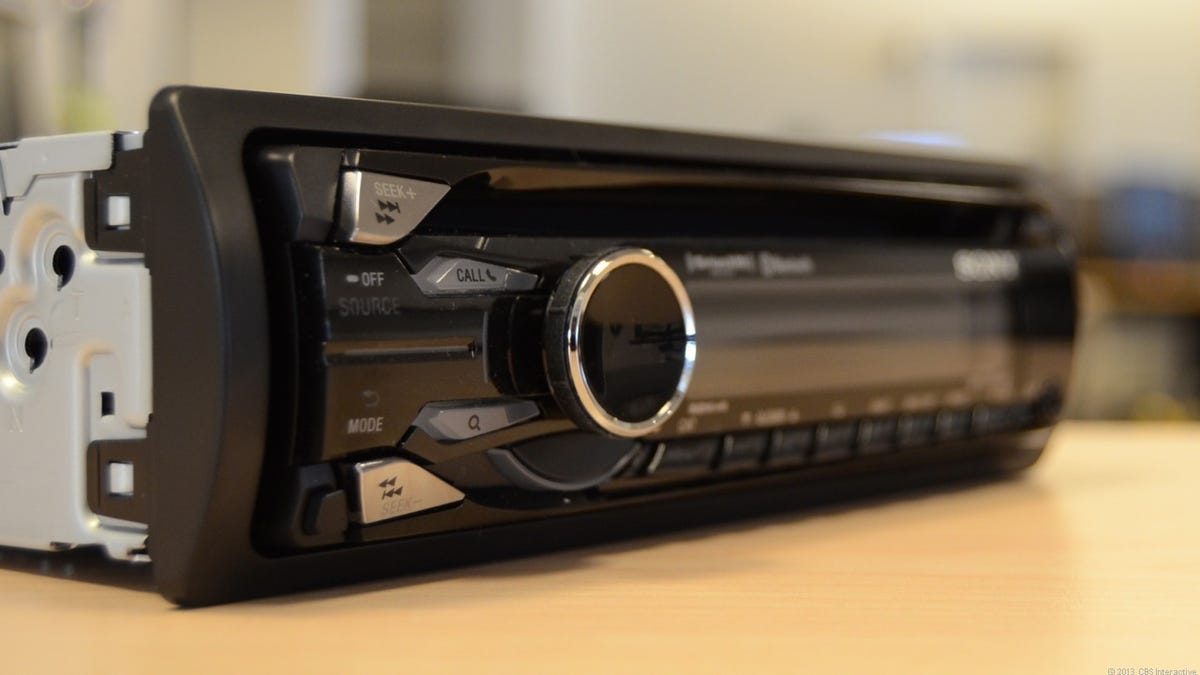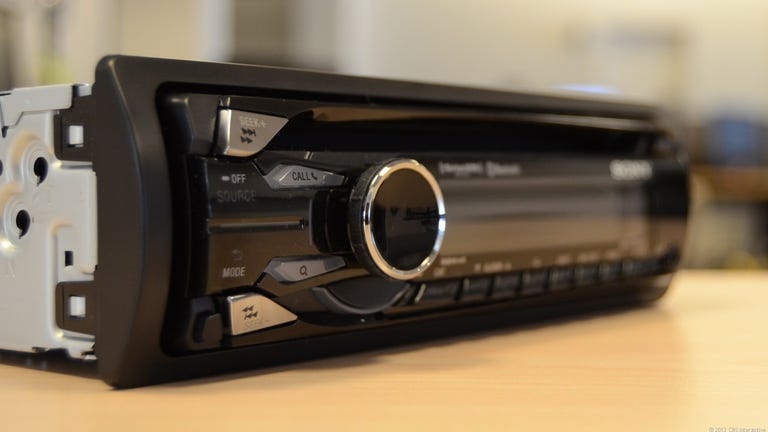 Why You Can Trust CNET
Why You Can Trust CNET Sony MEX-GS600BT Bluetooth audio receiver review: Great car stereo adds a questionable new trick
Sony's MEX-series of car stereos pack a lot of tech into a small package, but the Sony MEX-GS600BT's new App Remote mode is a weird addition.
Back in the days of the Car Tech Live podcast, I was often (ahem, every week) asked, "What's the best way to add a lot of tech to my car without spending a lot of money?"
The Good
The Bad
The Bottom Line
The answer I most often gave was, "Check out Sony's MEX line of single-DIN car stereos. For about two Benjamins, you'll add Bluetooth hands-free calling, wireless audio streaming, and USB and auxiliary inputs, and upgrade the audio quality of your car's wimpy car stereo."
The Sony MEX-GS600BT is one of the latest units in the MEX line, keeping intact everything that I love about its family. This new receiver also brings an interesting, but rudimentary sort of two-way smartphone app integration to the table that had me ooh-ing and ahh-ing, even as I scratched my head over the usefulness of this new feature.
Design
The Sony MEX-GS600BT uses the familiar and basic single-DIN design and proportions. The unit features a removable faceplate on which you'll find a control knob, a bunch of buttons, and an LCD.

The control knob wears many hats. Usually, it is a volume control knob that twists freely with nice, bumpy detents along its rotation that give low-tech haptic feedback on how quickly you're cranking the volume. Tapping the center of the knob like a button enters the Sony MEX-GS600BT's menu system where the various options and settings can be accessed by, again, twisting the control knob and tapping to make selections.
To the left of the control knob are buttons for phone controls, audio source selection, and track skipping. In the extreme lower-left corner is the tiny button to detach the faceplate.
A largish monochrome LCD occupies most of the faceplate. This display is larger than, for example, the display on the Pioneer DEH-X9500BHS that I reviewed recently, but it is less sophisticated, possessing only the resolution of a large desk calculator. Consequently, the unit is able to display only a single, large line of text with up to 12 visible characters at a time. Small icons at the extreme right edge of the screen relay additional information about the Bluetooth phone connection, paired phone's battery life and signal strength, and so on.
Below the display is a bank of eight multifunction keys that vary in operation depending on the source. For example, they can be preset radio station shortcuts when you're listening to the radio or they can be folder navigation and playback mode selectors when playing back MP3s from a USB.
Inputs and installation
On the unit's faceplate you'll find a single-slot CD player that can accept store-bought discs and home-burned CD-R/RW discs encoded with Red Book audio, or MP3, WMA, or AAC digital audio files. The faceplate is also home to the unit's 3.5mm analog auxiliary input.
To find the rest of the inputs and outputs, you'll have to spin the deck around to check out the back panel. Here, you'll find the standard car antenna connection point, as well as the wire harness connection with leads for 12-volt power and the speaker-level connections for the internal amplifier that outputs a maximum of 52 watts (17 watts RMS) through its four channels. The harness also features amp remote turn-on and illumination sensor connections. It's all standard stuff, if you've installed a car stereo within the last 20 years.
There's a single USB input on the end of a long extension cable that you can route through your vehicle's glove compartment or center console for easy access when the deck is installed in your dashboard. Additionally, you'll find a 2.5mm input for the included microphone that is used with the hands-free calling function.
A SiriusXM input makes it possible to add a satellite radio tuner (sold separately) for an additional audio source. A bank of three stereo RCA outputs send pre-amplified, line-level audio to external amplifiers should you decide to add them. Two of the outputs send full-range audio; the third is a dedicated subwoofer output that passes only low-frequency audio.
Bluetooth hands-free calling and audio streaming
One of the biggest selling points of the MEX line of Sony receivers is their built-in Bluetooth wireless connections.
The Sony MEX-GS600BT features fast Bluetooth pairing with phones that support the feature. There's no need to input a PIN, simply initiate the pairing and confirm that the numbers on the receiver and your handset match. Upon pairing, the MEX-GS600BT will attempt to sync your phone's contacts and address book. When you're ready to make a hands-free call, you'll be able to quickly search throughyour contacts by spinning the control knob.
Those who prefer voice command can access the phone's voice dialer or voice-search function via a menu option. I'd have liked for Sony to include a voice-dial button for faster access to what should be an eyes-free process.
Call quality largely depends on your paired phone, the network that you're connected to, and the quality of the speakers that you connect to the Sony MEX-GS600BT, but callers that I spoke with during my testing said I could be heard clearly.
The Bluetooth connection also enables wireless audio streaming via Bluetooth A2DP for phones and devices that support the profile. Rudimentary AVRCP transport controls, such as skipping forward and back, are supported via this connection.
The perplexing App Remote mode
The Sony MEX-GS600BT has a party trick that is sort of awesome, but also sort of weird. I'm still on the fence about its usefulness, but allow me to explain how the App Remote works.
The App Remote is an app that is downloaded and installed on an Android or iOS device that gives the user two-way control between the in-dash receiver and the apps on the smartphone. I did my testing with a Bluetooth-paired Samsung Galaxy Nexus running the latest version of Android Jelly Bean, but the functions described below should work identically with an iOS device via USB.
Once launched and connected to the receiver, the app presents a bank of shortcuts for the receiver's available audio sources that you can tap to quickly jump between. Additionally, you can add shortcuts to your favorite audio and navigation apps. There are no limitations on what apps can be added, so there's nothing but your own good judgement stopping you from adding Facebook or Temple Run 2 to the list of shortcuts. (Please, don't.)
Once you've got your shortcuts set up, tapping the Source button on the Sony MEX-GS600BT's faceplate will bring up the App Remote app and allow you to quickly choose any of these shortcuts by either twisting the control knob and tapping to launch the app or on-device source or by swiping and tapping an icon on your phone's touch screen. The app names are even reflected on the Sony MEX-GS600BT's LCD screen, which is a very nice touch.
On paper, the App Remote mode sounds cool, but it has one major flaw: it lets you jump between apps quickly, but you'll still need access to your phone's screen to interact with those apps. Unless your audio-streaming app automatically starts playing when launched, you'll still need to tap "play" on, for example, Spotify. It reduces driver distraction, but doesn't eliminate it.
I found it useful to mount my smartphone near the MEX-GS600BT's home in the dashboard, add shortcuts to my favorite podcasting apps, audio-streaming apps, and navigation apps, and use the source-selection button to quickly jump between viewing a map when navigating and picking a playlist while simultaneously listening to audio.
Other audio sources
The Sony MEX-GS600BT's full array of audio sources can be accessed via the App Remote or -- obviously -- through the on-unit source selection menu.
The receiver features AM/FM radio tuning, CD playback, and USB audio playback of MP3, AAC, and WMA audio with the ability to browse folders via the unit's menu. When connected via USB, an iPhone or iPod device's media hierarchy can also be browsed and played back via the Sony MEX-GS600BT's interface. Of course, the 3.5mm input on the faceplate of the receiver allows simple analog audio input from any auxiliary audio source.
Like many advanced car audio receivers, this Sony unit also features PandoraLink control of the Pandora Internet Radio app. Once it's connected to a phone running the app via the appropriate connection (USB for iOS devices or Bluetooth for Android phones), you can browse your preset radio stations, skip tracks, and give songs a thumbs-up or thumbs-down. The LCD does a fairly good job of displaying as much of the metadata for the currently playing song as fits within its 16-character limit.
However, the unit's dependence on the bank of identically small buttons with even tinier labels beneath the LCD means the thumbs-up and -down functions aren't as easy to access without looking as those actions are on competing models from Alpine, for example. You'll be squinting at the screen the first few times you try to access the function and may find yourself accidentally rating a few songs incorrectly. It's not so bad that it's frustrating (I simply abstained from rating songs while driving), but it bears mentioning.
In sum
The Sony MEX-GS600BT is a good way to add Bluetooth hands-free calling, a modern array of digital-audio connections, and a rudimentary level of smartphone app integration to any car with space for a single DIN receiver -- which, generally speaking, is all of them.
App Remote mode is cool, but it is basically simpler app switcher. By itself, the function doesn't really eliminate driver distraction from apps versus a naked Bluetooth A2DP audio connection. Combined with a dashboard mount for your smartphone, the App Remote does reduce the amount of time spent looking at the screen and tapping tiny icons when, for example, firing up your favorite navigation app.
At about $200, Sony MEX-GS600BT is also a relatively inexpensive receiver and is a good value when you consider all of the value added. The low-profile appearance will likely draw less attention from most would-be thieves than a $1,000-plus double-DIN receiver would, and the detachable faceplate will deter the rest.
I should also mention that the Sony MEX-GS600BT includes a small IR remote control that replicates many of the controls from the unit's faceplate. Who actually uses these things!? Let me know in the comments below.


